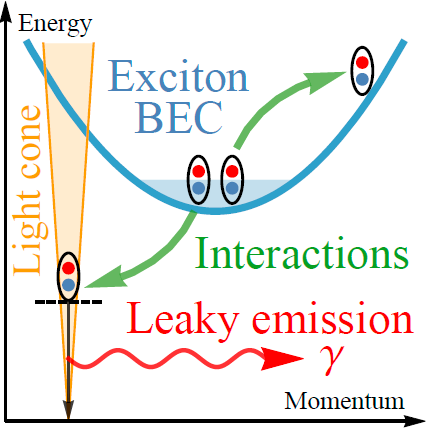Research Highlights
Moire exciton condensates spring a leak
A new study identifies novel many-body optical signatures of twisted bilayer excitons that are thought to be dark.

Semiconductors host electron-hole pairs called excitons. Excitons are bosons, and form Bose-Einstein condensates (BECs) at low temperatures. This however is hindered by the rapid recombination of the electron and hole, thereby annihilating the exciton and emitting its energy as light. To mitigate this problem, exciton BECs are now pursued in atomically-thin bilayers, where the separation of holes and electrons to opposite layers results in slow recombination. Exciton lifetimes are further enhanced by rotating one layer with respect to the other: in a twisted bilayer, the band gap becomes indirect, and momentum conservation forbids the conversion of excitons to photons. Unfortunately, this forbidding of emission prevents the BEC from being studied optically.
Conversely, the interlayer twist leads to the formation of a large-scale structure known as a moire pattern, and excitons become trapped in points where the two layers align. This trapping promotes strong interactions between the excitons. Remez and Cooper put forward that such strong interactions produce an emergent many-body optical process: when one exciton recombines, others can absorb the emission recoil momentum. This is understood as an excitonic Mossbauer effect, with distinct spectroscopic signatures. Remez and Cooper show that this is a dominant recombination mechanism at the low temperatures where excitons condense. Moire exciton BECs are thus not truly dark; rather they are "leaky condensates" from which photons trickle. Their results open the door to optical characterization of bilayer exciton BECs, and lay the groundwork for future studies of correlated exciton optoelectronics.
Leaky Exciton Condensates in Transition Metal Dichalcogenide Moire Bilayers Physical Review Research 4 L022042 (2022)